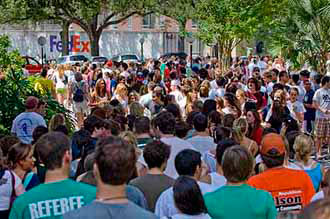Newcomb-Tulane College Ready for Supersized Class
A university that after Hurricane Katrina saw its freshman enrollment cut in half, Tulane appears to be taking in stride the challenges associated with quite a different exigency providing enough courses for this year's record-breaking enrollment.

This fall semester welcomes the largest class of incoming first-year students ever at Tulane. (Photo by Paula Burch-Celentano)
“Starting in early spring we have been carefully modeling our expected course needs based on different assumptions about the size of the incoming class, since the final count was not known until May. Then we began to fine-tune over the summer,” says James MacLaren, dean of Newcomb-Tulane College, the academic home for the university's full-time undergraduates.
According to the latest figures, 1,563 freshmen have enrolled in the university for the fall semester. Add the 133 students transferring to the university from other schools, and the number of new students enrolling in Tulane is 1,696, exceeding the fall 2005 record number of 1,679.
(The fall 2005 semester was cancelled because of damage to the university and city after Katrina.)
For MacLaren, who also holds a faculty position in the physics department, calculating how to meet the enrollment bump was not exactly quantum mechanics. “With an increase of about 20 percent [in freshman enrollment], we would look at a class such as Spanish 203, and we estimate that we would probably have 20 percent more first-year students enrolled, so from that you sort of figure your need and add extra sections of that class to meet that need,” he says.
Complicating matters somewhat in freshman writing, for example, which is a required first-year course, is that roughly 25 percent of the incoming class was expected to arrive with advanced placement credit for English 101. “So you take 75 percent and divide by two because half can take their courses in the spring, and that is our best estimate of the number of sections needed,” MacLaren says.
Language courses are among several in the curriculum where for various reasons administrators can expect “bottlenecks.”
“You can't teach a language to 50 students,” says MacLaren, “so you open up new sections.”
Other courses that hold potential for being overbooked by first-year students are English, math, dance, studio art and science labs.
Political science is always a popular major and its course offerings may be of even greater demand with growing student interest in America's place in the world, says MacLaren.
However, MacLaren says, this kind of prediction “is not an exact science.”
Filling the need for instruction in the additional sections is typically a departmental decision, says MacLaren. Some departments have added sections by hiring additional adjunct instructors or having instructors teach additional sections. Some have hired visiting faculty or professors of practice, which are full-time positions.
Administrators also expanded the number of Tulane InterDisciplinary Experience Seminars offered to freshmen. A popular TIDES course in management offered by the A. B. Freeman School of Business was expanded from 36 sections last year to 50 this year, says Michael Hogg, associate provost who is also on the business school's faculty.
Additionally, the Academic Advising Center's budget was increased this year, with the ranks of advisers growing in order to lower the adviser-to-student ratio, says Hogg, who worked with MacLaren in preparing for the supersized class. Also, the Educational Resource Center and the Office of Disabilities Services are extending their hours to meet increased demand.
“Overall,” says Hogg, “we anticipated early on that we would have a large freshman class and we took the steps early to make sure students would have courses to choose from and proper advising to guide them.”
